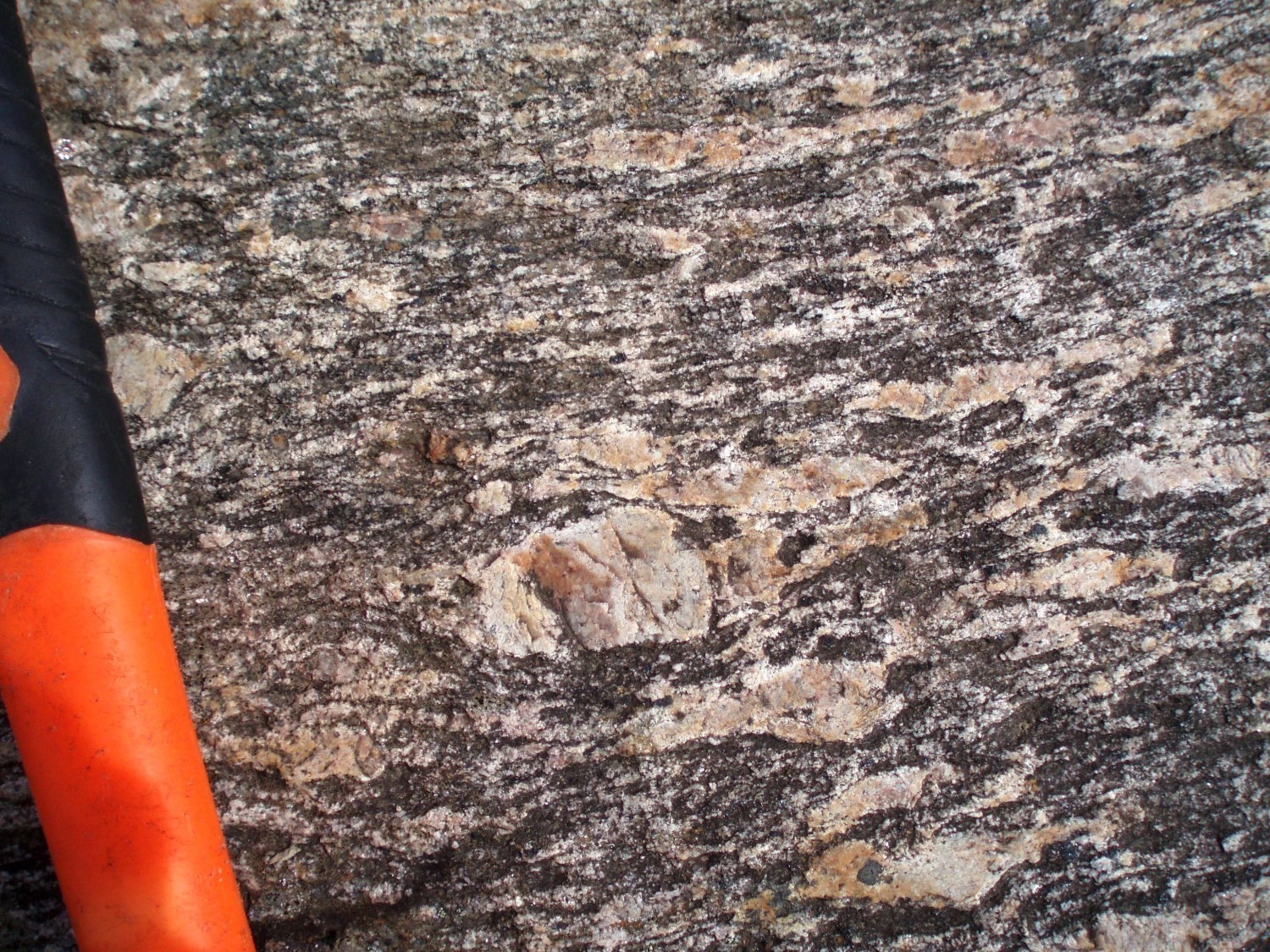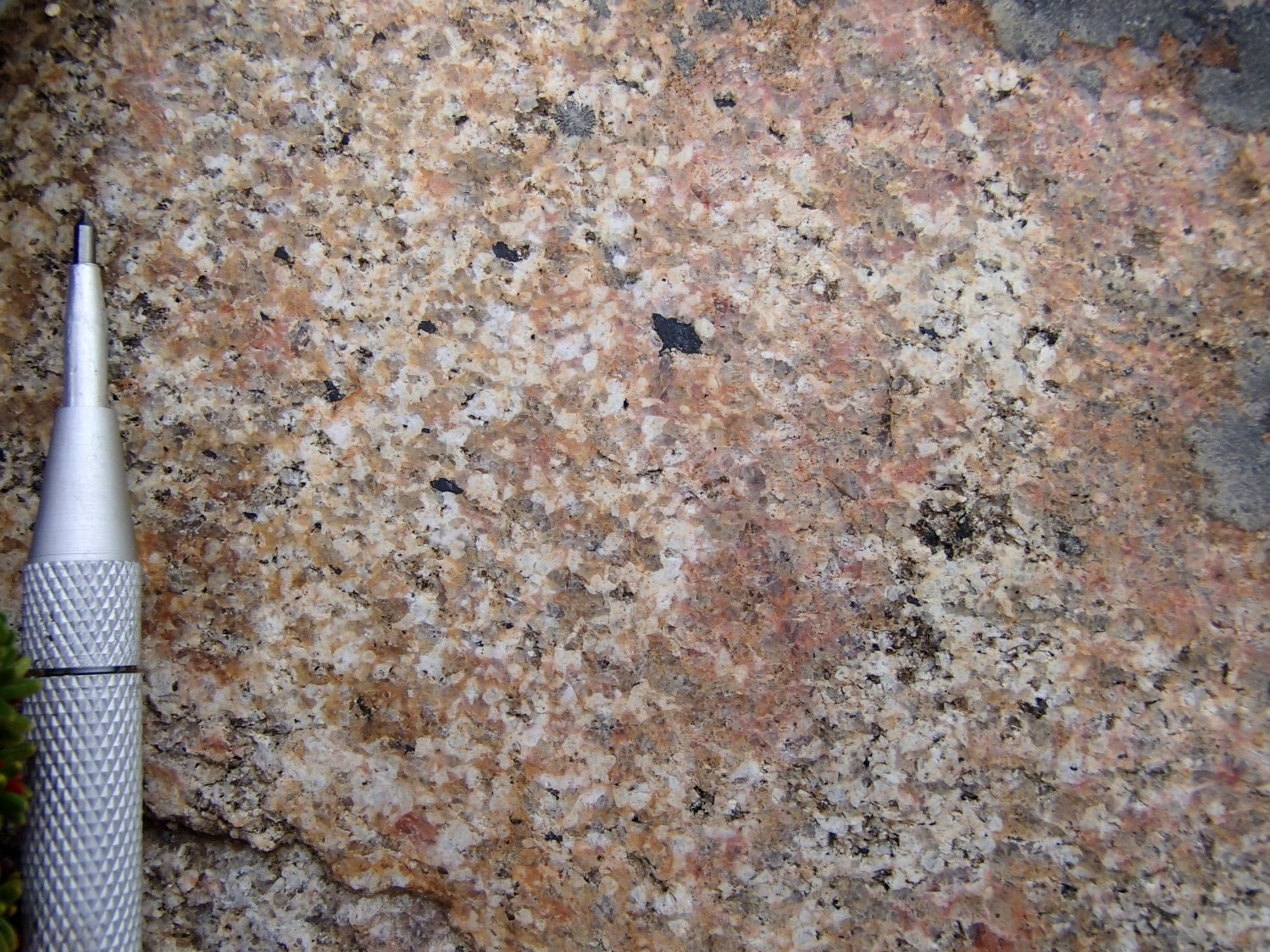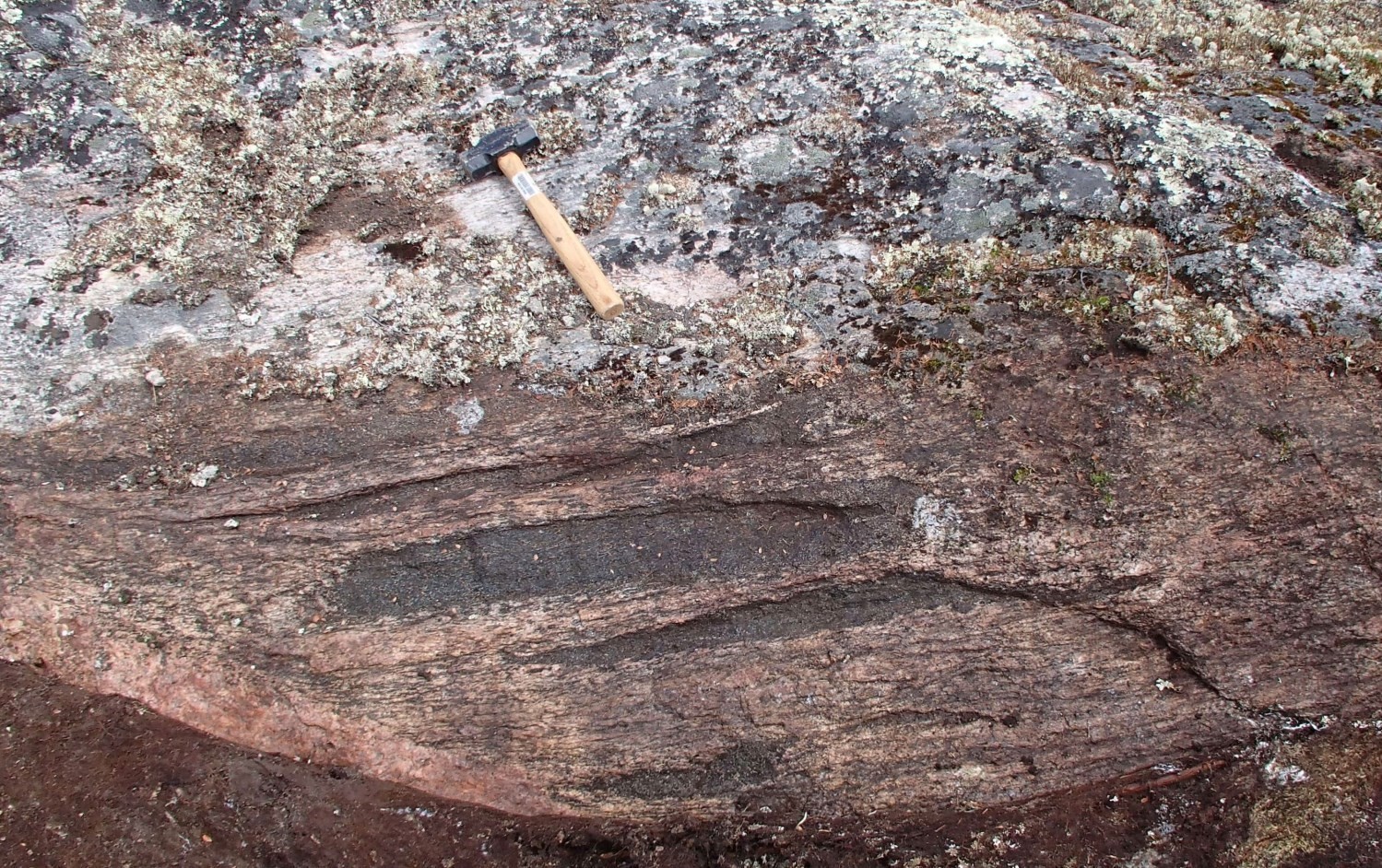
DISCLAIMER: This English version is translated from the original French. In case of any discrepancy, the French version shall prevail.
| Author(s): | Lafrance et al., 2014 |
| Age: | Neoarchean |
| Stratotype: | None |
| Type area: | Saffray Lake area (NTS sheet 24G) |
| Geological province: | Churchill Province |
| Geological subdivision: | Rachel-Laporte Lithotectonic Domain |
| Lithology: | Potassic felsic intrusions |
| Category: | Lithodemic |
| Rank: | Complex |
| Status: | Formal |
| Use: | Active |
None
Background
The Highfall Complex was defined by Lafrance et al. (2014) in the Saffray Lake area (sheet 24G) to group potassic intrusions circumscribed to a thrust sheet of the Rachel-Laporte Lithotectonic Domain (Lafrance and Vanier, 2021). Thus, it is more precisely a structural complex. Clark (1980) had also described greyish and pinkish granitic intrusions in the area, having or not an augen texture.
Description
The Highfall Complex consists of three units: 1) porphyraceous monzogranite and quartz monzonite (ApPhig1); 2) granite (ApPhig2); and 3) amphibolitized diorite and gabbro (ApPhig3).
Highfall Complex 1 (nAhig1): Porphyraceous Monzogranite and Quartz Monzonite
 Porphyraceous rocks of unit nAhig1 are homogeneous, very well foliated and have a high magnetic susceptibility. They are greyish, medium to coarse grained, and contain 10-30% pink K-feldspar phenocrystals 0.5-3 cm. Phenocrystals are partially recrystallized and very well aligned in foliation. In places, they are highly stretched and appear as discontinuous bands. Ferromagnesian minerals (10-25%) commonly combine into lenticular clusters a few millimetres wide, composed mainly of brown to green biotite with lesser amounts of hornblende (4-6%), epidote (2-4%) and magnetite (1-3%). Accessory minerals (3-6%) are usually attached to ferromagnesian mineral clusters and consist of sphene, apatite, allanite, muscovite and small zircon grains as inclusions in biotite. Sericite, carbonates and epidote are alteration minerals observed in feldspar crystals.
Porphyraceous rocks of unit nAhig1 are homogeneous, very well foliated and have a high magnetic susceptibility. They are greyish, medium to coarse grained, and contain 10-30% pink K-feldspar phenocrystals 0.5-3 cm. Phenocrystals are partially recrystallized and very well aligned in foliation. In places, they are highly stretched and appear as discontinuous bands. Ferromagnesian minerals (10-25%) commonly combine into lenticular clusters a few millimetres wide, composed mainly of brown to green biotite with lesser amounts of hornblende (4-6%), epidote (2-4%) and magnetite (1-3%). Accessory minerals (3-6%) are usually attached to ferromagnesian mineral clusters and consist of sphene, apatite, allanite, muscovite and small zircon grains as inclusions in biotite. Sericite, carbonates and epidote are alteration minerals observed in feldspar crystals.
Highfall Complex 2 (nAhig2): Granite
 Unit nAhig2 granite is the youngest phase of the Highfall Complex. It contains decimetric to metric enclaves of other units of the complex and occurs as centimetric to metric injections within unit nAhig1. Granite is pinkish, medium grained, even grained and well foliated. Quartz, microcline and plagioclase contents are similar. Granite contains 2-12% ferromagnesian minerals consisting of brown biotite, locally chloritized, with some hornblende, epidote and fine magnetite. Accessory minerals are the same as in unit nAhig1, but in smaller amounts.
Unit nAhig2 granite is the youngest phase of the Highfall Complex. It contains decimetric to metric enclaves of other units of the complex and occurs as centimetric to metric injections within unit nAhig1. Granite is pinkish, medium grained, even grained and well foliated. Quartz, microcline and plagioclase contents are similar. Granite contains 2-12% ferromagnesian minerals consisting of brown biotite, locally chloritized, with some hornblende, epidote and fine magnetite. Accessory minerals are the same as in unit nAhig1, but in smaller amounts.
Highfall Complex 3 (nAhig3): Amphibolitized Diorite and Gabbro
 Potassic rocks of units nAhig1 and nAhig2 contain boudinaged enclaves, centimetre to metre-wide, of melanocratic rocks stretched parallel to foliation. Some of these enclaves form klippes of significant width compiled from the work of Clark (1980) and assigned to unit nAhig3. This author describes these klippes as consisting of amphibolitized, foliated, fine to medium-grained diorite and gabbro, composed mostly of plagioclase with some biotite.
Potassic rocks of units nAhig1 and nAhig2 contain boudinaged enclaves, centimetre to metre-wide, of melanocratic rocks stretched parallel to foliation. Some of these enclaves form klippes of significant width compiled from the work of Clark (1980) and assigned to unit nAhig3. This author describes these klippes as consisting of amphibolitized, foliated, fine to medium-grained diorite and gabbro, composed mostly of plagioclase with some biotite.
Thickness and distribution
The Highfall Complex is located in the NW part of the Saffray Lake area (Lafrance et al., 2014), where it forms a thrust sheet ~35 km long by 12 km wide elongated in a NW-SE direction within the Rachel-Laporte Lithotectonic Domain. It covers an estimated area of 447 km2.
Dating
The Archean age obtained in quartz monzonite (outcrop 2012-DB-1029) is similar to that of granitic gneiss of the Rénia Complex, just north of the Highfall Complex. It is also similar to those obtained in quartz monzonite of the Saffray Suite, in the Baleine Lithotectonic Domain.
| Unit | Sample Number | Isotopic System | Mineral | Crystallization Age (Ma) | (+) | (-) | Reference(s) |
| nAhig1 | 2012-DB-1029A | U-Pb | Zircon | 2705 | 8 | 8 | Davis et al., 2015 |
Stratigraphic Relationship(s)
The Highfall Complex is part of a large thrust sheet separated in half by a thrust fault delineating two complexes: the Rénia Complex in the north and the Highfall Complex in the south. This sheet is composed of rocks that would originate from the Archean basement, and would have been emplaced within Paleoproterozoic volcano-sedimentary rocks of the Rachel-Laporte Lithotectonic Domain during the New Quebec Orogenesis (1.82-1.77 Ga; Machado et al., 1989). It is therefore in fault contact with Laporte Supersuite units. The northern section of the sheet is interpreted as having partially overthrusted the southern section towards the end of deformation.
Paleontology
Does not apply.
References
Publications available through SIGÉOM Examine
CLARK, T., 1980. REGION DE LA RIVIERE KOKSOAK (NOUVEAU-QUEBEC) – RAPPORT PRELIMINAIRE. MRN; DPV 781, 24 pages, 1 plan.
DAVIS, D W., MOUKHSIL, A., LAFRANCE, I., HAMMOUCHE, H., GOUTIER, J., PILOTE, P., TALLA TAKAM, F., 2015. Datations U-Pb dans les provinces du Supérieur, de Churchill et de Grenville effectuées au JSGL en 2012-2013. MERN; RP 2014-07, 56 pages.
LAFRANCE, I., SIMARD, M., BANDYAYERA, D., 2014. GEOLOGIE DE LA REGION DU LAC SAFFRAY (SNRC 24F, 24G). MRN; RG 2014-02, 51 pages, 1 plan.
LAFRANCE, I., VANIER, M.-A. 2021. Domaine lithotectonique de Rachel-Laporte, Sud-est de la Province de Churchill, Québec, Canada : synthèse de la géologie. MERN; BG 2021-01
Other publications
MACHADO, N., GOULET, N., GARIEPY, C. 1989. U-Pb geochronology of reactivated Archean basement and of Hudsonian Trough. Canadian Journal of Earth Sciences; volume 26, pages 1-15. https://doi.org/10.1139/e89-001
Suggested Citation
Ministère de l’Énergie et des Ressources naturelles (MERN). Highfall Complex. Quebec Stratigraphic Lexicon. https://gq.mines.gouv.qc.ca/lexique-stratigraphique/province-de-churchill/complexe-de-highfall_en [accessed on Day Month Year].
Contributors
|
First publication |
Isabelle Lafrance, P. Geo., M.Sc. isabelle.lafrance@mern.gouv.qc.ca (redaction) Mehdi A. Guemache, P. Geo., Ph.D. (coordination); Charles Gosselin, M.Sc. (critical review); Simon Auclair, P. Geo., M.Sc. (editing); Céline Dupuis, P. Geo., Ph.D. (English version); Nathalie Bouchard (HTML editing). |

